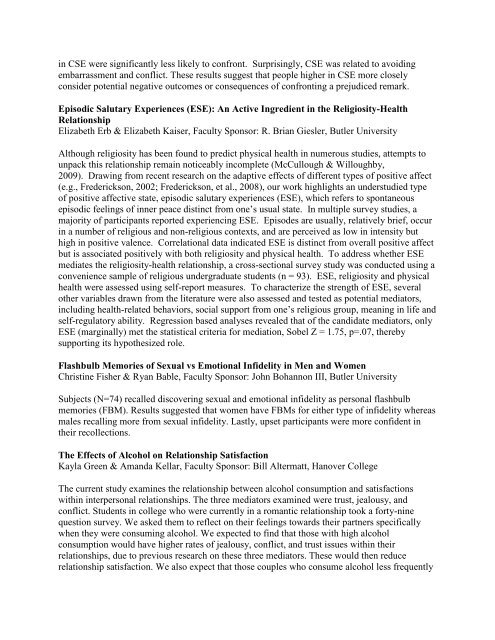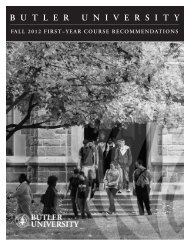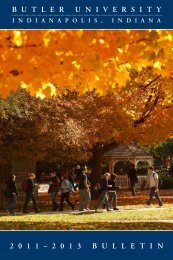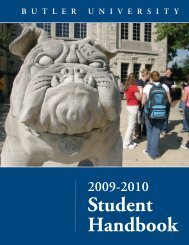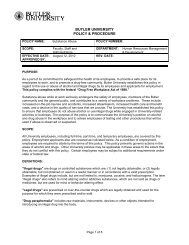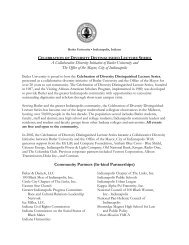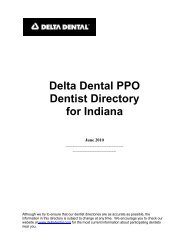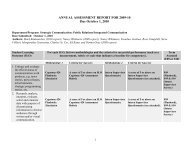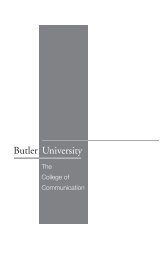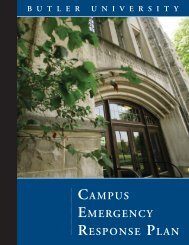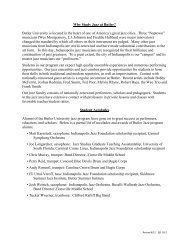Anthropology - Butler University
Anthropology - Butler University
Anthropology - Butler University
You also want an ePaper? Increase the reach of your titles
YUMPU automatically turns print PDFs into web optimized ePapers that Google loves.
in CSE were significantly less likely to confront. Surprisingly, CSE was related to avoiding<br />
embarrassment and conflict. These results suggest that people higher in CSE more closely<br />
consider potential negative outcomes or consequences of confronting a prejudiced remark.<br />
Episodic Salutary Experiences (ESE): An Active Ingredient in the Religiosity-Health<br />
Relationship<br />
Elizabeth Erb & Elizabeth Kaiser, Faculty Sponsor: R. Brian Giesler, <strong>Butler</strong> <strong>University</strong><br />
Although religiosity has been found to predict physical health in numerous studies, attempts to<br />
unpack this relationship remain noticeably incomplete (McCullough & Willoughby,<br />
2009). Drawing from recent research on the adaptive effects of different types of positive affect<br />
(e.g., Frederickson, 2002; Frederickson, et al., 2008), our work highlights an understudied type<br />
of positive affective state, episodic salutary experiences (ESE), which refers to spontaneous<br />
episodic feelings of inner peace distinct from one’s usual state. In multiple survey studies, a<br />
majority of participants reported experiencing ESE. Episodes are usually, relatively brief, occur<br />
in a number of religious and non-religious contexts, and are perceived as low in intensity but<br />
high in positive valence. Correlational data indicated ESE is distinct from overall positive affect<br />
but is associated positively with both religiosity and physical health. To address whether ESE<br />
mediates the religiosity-health relationship, a cross-sectional survey study was conducted using a<br />
convenience sample of religious undergraduate students (n = 93). ESE, religiosity and physical<br />
health were assessed using self-report measures. To characterize the strength of ESE, several<br />
other variables drawn from the literature were also assessed and tested as potential mediators,<br />
including health-related behaviors, social support from one’s religious group, meaning in life and<br />
self-regulatory ability. Regression based analyses revealed that of the candidate mediators, only<br />
ESE (marginally) met the statistical criteria for mediation, Sobel Z = 1.75, p=.07, thereby<br />
supporting its hypothesized role.<br />
Flashbulb Memories of Sexual vs Emotional Infidelity in Men and Women<br />
Christine Fisher & Ryan Bable, Faculty Sponsor: John Bohannon III, <strong>Butler</strong> <strong>University</strong><br />
Subjects (N=74) recalled discovering sexual and emotional infidelity as personal flashbulb<br />
memories (FBM). Results suggested that women have FBMs for either type of infidelity whereas<br />
males recalling more from sexual infidelity. Lastly, upset participants were more confident in<br />
their recollections.<br />
The Effects of Alcohol on Relationship Satisfaction<br />
Kayla Green & Amanda Kellar, Faculty Sponsor: Bill Altermatt, Hanover College<br />
The current study examines the relationship between alcohol consumption and satisfactions<br />
within interpersonal relationships. The three mediators examined were trust, jealousy, and<br />
conflict. Students in college who were currently in a romantic relationship took a forty-nine<br />
question survey. We asked them to reflect on their feelings towards their partners specifically<br />
when they were consuming alcohol. We expected to find that those with high alcohol<br />
consumption would have higher rates of jealousy, conflict, and trust issues within their<br />
relationships, due to previous research on these three mediators. These would then reduce<br />
relationship satisfaction. We also expect that those couples who consume alcohol less frequently


